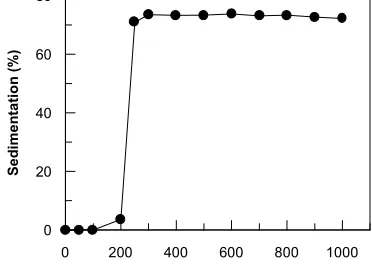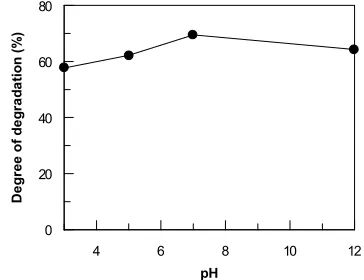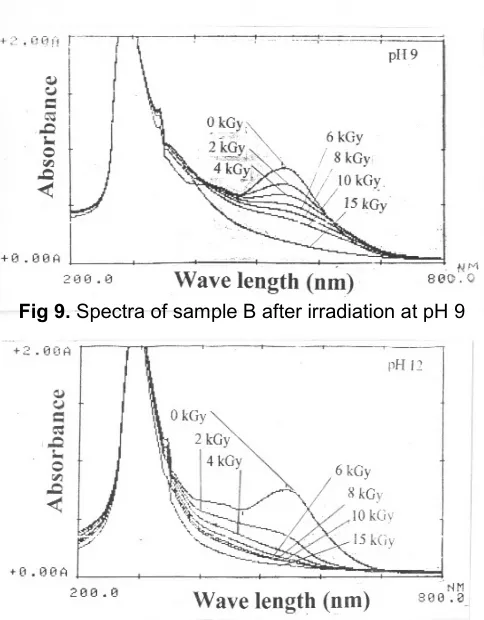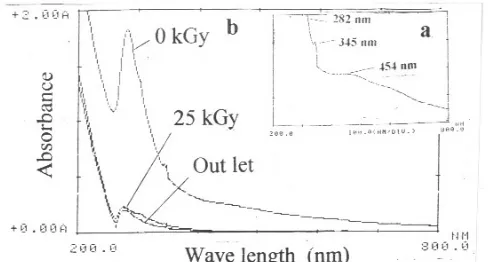* Corresponding author. tel/fax : 021-7690709 ext 161/021-7513270 Email address : agustinnmb@yahoo.com
THE ADDITION OF SOME COAGULANT AND VARIATION OF pH ON DEGRADATION OF
TEXTILE WASTEWATER USING GAMMA RADIATION
Agustin Sumartono
*, Winarti Andayani Lindu and Ermin K. Winarno
Centre for the Application Technology of Isotopes and Radiation, National Nuclear Energy Agency, Jl Cinere Pasar Jumat PO 7002 JKSKL Jakarta 12070
Received 31 July 2006; Accepted 5 September 2006
ABSTRACT
The degradation and decolouration of textile waste water by gamma irradiation has been studied. Textile wastewater contain a mixture of dyes that difficult to degrade using conventional method, therefore it is necessary to find another method to degrade those dyes. Samples from effluent of textile industry were taken at certain time and have different in colour and condition. The addition of coagulant and radiation to remove the colour of the samples were demonstrated. Four kind of treatments were carried out in this experiment namely addition of coagulant, radiation, variation of pH and radiation, and combination of radiation with the addition of coagulant. The parameters examined were the change of spectra intensity, percentage of sedimentation after the addition of coagulant, and the percentage of the degradation. Combination of irradiation and the addition of coagulant induced decolouration and degradation of the waste.
Keywords:radiation, degradation, decoloration, textile wastewater.
INTRODUCTION
Wastewater containing dyes from textile industries are not easily degraded by an ordinary treatment processes and cause environmental problems. The dyes that usually used in textile industries are reactive, basic, acid, direct and disperse, these compounds are non-biodegradable materials. Wastewater released by those industries contains toxic refractory dye stuffs at high concentration. They will go into the environment and contaminate surface water and the water itself. A conventional method was used for decolouration and degradation of such dyes, but improvement has not been reached yet, since the method is still releasing some amount of sludge. Environmental Management Control (EMC) Jakarta, Indonesia reported that decolouration of colouring waste water was still difficult to be solved, so that the use of another method was necessary [1-3].
Some researcher have reported that radiation induced decolouration and degradation of disperse, acid and reactive dyes, so that radiation technology could be an alternative method to solve the textile industries problem [1-5]. Textile wastewater contains high concentration of pollutants of complex components, therefore high dose are required to treat these wastewater by radiation only. To decrease the dose, some combination method with coagulation and variation of pH were required.
The objective of the study is to degrade and decolour the wastewater that was taken from textile industry. The addition of coagulant, radiation, variation of pH and radiation, and combination of radiation with the
addition of coagulant were used to degrade and decolour it and discussed in this paper.
EXPERIMENTAL SECTION
Material
Samples of dyes waste water were taken from the effluent of textile industry of PT.Unitex, Bogor Indonesia at a certain time. The samples were taken four times from the effluent at different time and one sample from out let. Four samples was taken from out let and labelled as A, B, C, and D. Each samples have different in colour and performance therefore different treatment should be applied. One sample was taken from the outlet of the wastewater process (E). The samples were kept in plastic jars of 5 liters volume. Irradiation was done with cobalt-60 rays at room temperature and placed in 500 mL Pyrex reaction-vessel (5 cm dia. and 16 cm height). The dose rate of 5 kGy/h was determined by a Fricke dosimeter. During irradiation air was bubbled into the sample.
Instrumentation
The absorption band was measured with a Shimadzu UV-160 spectrophotometer. The pH of the solution was measured with a Metrohm 620 pH meter
Procedure
1000
ammonium iron (III) sulfate (ppm)
S
sample A was 10. In this experiment sample A was divided into 3 treatments namely, A1, A2 and A3.
A1, sample A was carried out with the addition of ammonium iron (III) sulfate as a coagulant at concentration of 50-1000 ppm to remove the colour and followed by measuring absorbance the upper layer using spectrophotometer UV-VIS. In this case pH was adjusted to 6-7 before the addition of the coagulant. From this experiment the degree of sedimentation can be calculated. The objectives of this experiment is to find out whether the addition of the coagulant effectively degrade the colour of the sample A1.
A2, sample A was irradiated at original pH (10) at doses of 0, 5, 10, 15, 20 and 25 kGy and aerated. After irradiation the absorbance intensity of the sample was measured using spectrophotometer UV-VIS and the degree of degradation can be calculated. The objectives of this experiment is to find out whether the radiation itself could degrade the colour of the sample A2.
A3, sample A was irradiated at various pHs i.e. 3, 5, 7, and 12 at doses of 0, 2, 4, 6, 8, 10 and 15 kGy. After irradiation the intensity of the sample was measured using spectrophotometer UV-VIS. From this data the degree of degradation can be calculated. The objectives of this experiment is to find out whether pH could influence the degradation of the sample A3.
Sample B. Sample B is dark purple in colour and has no insoluble material. The original pH of the sample B was 9.3. In this experiment radiation was done at various pHs i.e 3, 5, 7, 9, and 12 at doses of 0, 2, 4, 5, 6, 8, 10, 15, 20, 25 and 30 kGy without addition of coagulant and aerated. The parameters examined were absorption spectra and the percentage of degradation. The objectives of this experiment is to achieve the best degradation at pH optimum.
Sample C. Sample C is red in colour and has no insoluble material, the original pH of the sample C is 5.2. Irradiation of sample C was carried out at doses of 0, 0.5, 1, 1.5, 2, 3 and 4 kGy, and at various pHs i.e. 3, 5, 7, 9 and 12. In this experiment no addition of coagulant is needed. The degree of degradation was estimated
Fig 1. Spectra of sample A1 after addition of NH4Fe(SO4)2at various concentration at 286 nm
from the reduction in optical density. The objectives of this experiment is to find out whether pH could influence the degradation of the sample C.
Sample D.Sample D is dark purple in colour and has some insoluble material. The objective of the study is to degrade the sample D using radiation with the addition of coagulant. In this experiment combination of radiation and addition of coagulant was done to remove the colour of the sample. The addition of 7000 ppm of Al2(SO4)3 was done into the sample and settled for 4
days. The upper layer was taken out and irradiated at doses of 0, 5, 10, 15, 20, and 25 kGy, aerated. The absorption spectra was measured using spectrophotometer UV-VIS. The spectrum of sample D was compared to that of sample taken from outlet. The objectives of this experiment is to find out whether radiation with the addition of coagulant could degrade the sample D.
RESULT AND DISCUSSION
Sample A
Sample A1. The addition of ammonium iron (III)
sulfate into the sample is needed to remove the colour of the sample A1. Ammonium iron (III) sulfate at concentration of 50-1000 ppm were added into the sample A1. After the addition of ammonium iron (III) sulfate the upper layer was measured using spectrophotometer UV-VIS. The upper layer is clear but has strong absorption at 286 nm in the uv region and weak absorption at 580 nm in the visible region. The former absorption is considered to be the main absorption assigned to the substituted aromatic rings and the latter can be assigned to the conjugated system of the dye molecules, as shown in Fig 1. The intensity in the uv and visible region decreased slowly by the addition of ammonium iron (III) sulfate at concentration of 0-250 ppm. However, when concentration ammonium iron (III) sulfate increased up to 300 ppm, the intensity of the spectrum in the uv
Fig 2. The degree of sedimentation after the addition
decreased markedly and then became almost constant beyond 300 ppm. The absorption in visible region has no intensity. These decreases in intensity are obviously due to the destruction of the substituted aromatic rings of the dye molecules by attack of OH radicals as in the case of water–soluble dyes [2-4]. The degree of sedimentation of sample A1 after the addition of ammonium iron (III) sulfate is shown in Fig 2. The degree of sedimentation was calculated from the reduction of optical density at 286 nm wave length by using the following equation :
Degree of sedimentation o i
o
where Aois the optical density of sample without addition
of coagulant and Ai is the optical density of the ith
addition of coagulant. These results is correspond to the measurement of the absorbance that could be seen from Fig 1. It is suggested that the degree of sedimentation of sample A1 could be achieved by the addition of 300 ppm of ammonium iron (III) sulfate. At this condition the degree of sedimentation was achieved to be 73.48%.
Sample A2. The change of the spectrum of sample
A2 after irradiation at original pH (10) without addition of coagulant is shown from Fig 3. The sample A2 has strong absorption at 286 nm and weak absorption at 580 nm. The absorption in the uv region decreased slowly as the dose increased. The intensity in the
Fig 3.Spectra of sample A2after irradiation at various
dose
Fig 4. The effect of irradiation on the degradation of
sample A2
visible region decreased markedly, it is indicated by changing the colour of the sample into a clear solution. The decreases in the uv region is obviously due to the destruction of the aromatic system. Degree of degradation was determined by measuring the spectra from the uv region (286 nm) as shown in Fig. 4. In this case the percentage of degradation of sample A2 increases up to dose 20 kGy and then remains constant at dose of 25 kGy. It is suggested that sample A2 contain a mixture of dyes which is insoluble, therefore the higher doses are needed for degradation.
Sample A3. Study on the degradation of sample
A3 at various pHs was carried out to obtain better achievement on the degradation of the sample. The effect of pH on the degradation of sample A3 is shown in Figure.5. It can be seen that at acidic medium (pH 3 and 5) or basic medium (pH 12) the degree of degradation is slightly lower than that of neutral medium. The degree of degradation of sample A3 could be carried out at pH 7 at dose of 10 kGy. At this stage the degree of degradation that could be achieved is 70%. The results showed that degradation could be carried out effectively at pH 7. From the aboved finding it is concluded that sample A3 should be coagulated before irradiation, the best pH for the treatment was 7, because no treatment is needed to neutralize the waste.
A possible explanation might be based on the acid-base properties of the OH radicals. In strong basic solution, the OH radicals dissociate to the less reactive Oradicals (5) : the reducing atoms are scavenged by oxygen leading to a formation of HO2, which can be involved in the
degradation of sample A3 process. In fact the degradation scheme depends on the relative reactivity of the various species, availability of oxygen, dose, pH of solution and temperature.
Fig 5. Effect of pH on the degradation of sample A3
25
Fig 6.Spectra of sample B after irradiation at pH 3
Fig 7.Spectra of sample B after irradiation at pH 5
Fig 8.Spectra of sample B after irradiation at pH 7
Sample B
Sample B has strong absorption at 291 nm in the uv region and weak absorption at 530 nm in the visible region as shown in Fig 6. The former absorption is considered to be the main absorption assigned to their substituted aromatic rings and the latter absorption can be assigned to the conjugated system of the dye molecules. Irradiation was done at various pHs i.e. 3, 5, 7, 9, and 12 and the spectra obtained were shown in Figs 6, 7, 8, 9, and 10, respectively. In this experiment, radiation was carried out at different pHs in order to get the best pH for the degradation because sample B has strong absorption at uv region which is difficult to degrade. The intensity of the spectra at 291 nm and pHs 5, 7, 9, and 12 remain constant at dose beyond 15 kGy.
Fig 9.Spectra of sample B after irradiation at pH 9
Fig 10.Spectra of sample B after irradiation at pH 12
Fig 11. Spectra of sample B after irradiation at pH 3
with doses of 0, 5, 10, 15, 20, 25 and 30 kGy
Fig 12.The degradation of sample B after irradiation at
pH 3
30 20
10 0
80
60
40
20
0
Absorbed dose (kGy)
D
e
g
ra
d
a
ti
o
n
(%
Fig 13. The spectra of sample C after irradiation at pH 3
Table 1. Degree of degradation of sample C at various
pHs
pH Dose (kGy)
3 5 7 9 12
0.5 33 38 28 26 15
1.0 54 53 44 42 25
1.5 70 65 56 55 32
2.0 80 74 64 62 36
3.0 90 82 74 72 42
4.0 93 87 79 78 46
On the other hand the intensity in the visible region decreased markedly. However at pH 3, the intensity of sample B in the uv and visible region decreased markedly. Therefore irradiation of sample B was carried out at pH 3 and dose of 30 kGy as can be seen in Fig 11. Degree of degradation was determined by measuring the spectra in the uv region (291 nm) and the results is shown in Fig 12. The maximum degradation of sample B was obtained to be 85% with dose of 30 kGy at pH 3. From these results, it is assumed that sample B may contain some insoluble dyes i.e disperse dyes. Usually disperse dyes used as mixture of dyes, certain surfactant and inorganic additive due to the insolubility of the dye in water (1).
Radiolysis of water will produce the primary products i.e. OH radical (OH), H radical(H), eaq, H2O2
and H2.Irradiation was carried out in the aerated system
therefore oxidative species (HO, HO2, and H2O2) were
dominant. The reaction ia as follows (5-6): H+ O2
HO2 (k= 2.1x1010
dm3mol-1s-1) eaq+ O2
O2 (k= 1.9x1010
dm3mol-1s-1) O2+ H
+
HO2
HO2+ HO2
H2O2+ O2The attack of oxidative species in the visible region (541 nm) proceed decoloration of the dye. From this data it is suggested that decolouration reaction is not necessarily accompanied by the destruction of substituted aromatic rings.
Fig 14. Spectra of sample D before the addition of
coagulant and irradiated (a) and after the addition of coagulant and irradiated (b) (0 kGy): (25 kGy) :Sample D after addition of coagulant followed by radiation with dose of 25 kGy; (out let): sample from outlet
Sample C
Sample C has strong absorption at 286 nm in the uv region and 513 nm in the visible region, as shown in Fig 13. The absorption in the uv region is assigned to be their substituted aromatic rings and the absorption in the visible region is considered to be conjugated system of the dye molecules. The intensity in the visible region decreased rapidly by increasing of the dose. This indicates that sample C may containing some dyes that soluble in water. As reported by [7] and [8] the absorption intensity decreased rapidly from the beginning of the irradiation for water-soluble dyes. Irradiation of sample C was done at various pHs i.e 3, 5, 7, 9, and 12 and the degree of degradation obtained was tabulated in Table 1. It is assumed from these data that sample C could be degraded at low dose (4 kGy) and acidic (pH 3). The degree of degradation at these condition was found to be 93%.
Sample D
Experiment of sample D was carried out by combining radiation and addition of coagulant. Sample D has strong absorption at 282 nm in the uv region and slight shoulder at 345 and 454 nm in the visible region as shown in Fig 14a. The spectrum in the uv region is assigned to the substituted aromatic rings and the spectrum in visible region is considered to their conjugated system of the dye molecules. First, [Al2(SO4)3] was added into sample D as a coagulant,
region hardly decrease as shown in Fig 14b (curve 0 kGy). After irradiation at dose of 25 kGy the intensity in the uv region decreased markedly (Fig 14b, curve 25 kGy). The intensity in the uv region is due to the aromatic rings from the dye molecules which is hard to degrade. These decreases in intensity are obviously due to the destruction of the aromatic rings of the dye molecules due to the attack of OH radicals which was formed from radiolysis of water. It is reported by [1-2] that degradation product of the dye that could be detected by HPLC are organic acids, in the further oxidation will be converted into CO2 and H2O. The
percentage of degradation after treatment with combination of addition of coagulant and radiation could be achieved 84.3%
This results were then compared with those of the sample taken from outlet as shown in Fig 14b (curve out let). By comparing the absorbance of sample outlet and sample D, it is clearly seen that the intensity of the absorbance of two spectrum is close to each other. From the above results it can be concluded that combination of radiation and coagulation could be used as an alternative method to treat textile wastewater to get better achievement.
CONCLUSION
Decolouration and degradation of textile waste water can be carried out either by coagulation, irradiation, combination of irradiation with variation of pH and combination of irradiation with the addition of coagulant. Combination of irradiation and coagulation induced the best results of decolouration and degradation of textile waste water. Degradation and decolouration of textile waste water could be carried out but the necessary dose varies with the type of the waste
ACKNOWLEDGEMENT
This work was partly supported by the International Atomic Energy Agency under grants RC 8801/RO. The authors are grateful to PT Unitex Bogor, Indonesia for their valuable help. Thanks are also due to Ms. Christina T.S, Mr. Armanu, Mr. Syurhubel and Mr. Firdaus for their technical assistance.
REFFERENCES
1. Bagyo NMA., Andayani W., and Sadjirun S., 1998, Radiation-Induced Degradation and Decoloration of Disperse Dyes in Water., Env.Appl. of Ionizing Radiat.Edited by William J.Cooper, Randy M.Curry and Kevin O’Shea, John Wiley & Sons, New York, 507-519.
2. Bagyo NMA., Lindu WA., Winarno H., and Winarno E.K., 2004,Int. J Env. Concs. Design & Manufac., 11, 1, 21-24.
3. Solpan D., and Guven O., 2002, Rad. Phys. & Chem., 65, 4, 549-558.
4. Wang, M., Yang, R., Wang, W., Shen, Z., Shaowei Bian and Zhu, Z., 2006, Rad Phys.& Chem.,75, 286-291.
5. Getoff N., 2002,.Rad. Phys. & Chem.,65, 4-5, 437-44
6. Gehringer P. and Eschweiler H., 2002, Rad. Phys.& Chem,65,4-5, 379-386
7. Ponomarev A.V., Makarov I.E., Bludenko A.V., Minin V.N., Kim D.K., Han B., and Pikaev A.K, 1999,Khim Vys. Ener,33, 3, 177-182.



